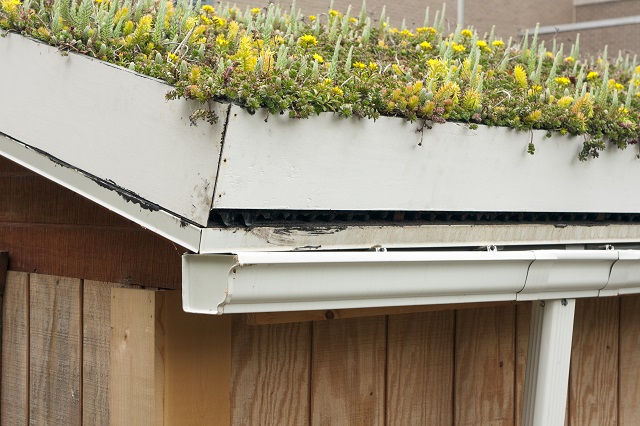
Though green roof construction is not as popular as metal or asphalt roofing, the performance of green roofs is so impressive that nearly anyone considering a new roof should take them into consideration. The idea of a roof made of living vegetation might seem novel to some, but green roof construction is gaining a reputation as one of the most practical roofing options around.
Eco-friendly homeowners have long been enamored with the environmental benefits of green roofs, but budget conscious homeowners will find the longevity, insulation, and overall performance of today’s green roofing options hard to miss. If you’ve been thinking about installing green roofing, or are simply curious about what makes this option such a shockingly good one, the following green roofing basics are sure to give you a better idea of why these installations are becoming so popular so quickly!
The Two Types of Green Roof Construction
While no two green roofs are exactly alike, all green roofing is broken down into two main categories: intensive and extensive. Both varieties of green roofing are energy efficient and both can last for a very long time, but for every scenario, one or the other is usually the clear winner when it comes to budget and performance.
Extensive green roofing is more common than intensive green roofing for several reasons. For one, extensive green roofing is much easier to plan and install; it is also more self-sufficient and more affordable than intensive green roofing. Extensive green roofing is more common in residential settings, and provides a level of flexibility that intensive green roofing couldn’t dream of matching. Extensive green roofs are usually installed with little to no pitch and require only a few inches of soil to function; when finished, extensive green roofing looks much like a lawn sitting on top of your house.
Intensive green roofing is most common on larger structures like apartment buildings and commercial structures. Because intensive green roofs are extremely sturdy and are designed to handle a wide variety of plants, many are accented with walkways, trees, and even gazebos. Intensive green roofing is much more expensive to install and requires a lot more maintenance than extensive green roofing; rarely seen in residential settings or on roofs with any sort of pitch or slope, the soil depth of an intensive green roof can range anywhere from 6 inches to several feet.
Residential Green Roof Construction
For the average homeowner, the expense of intensive green roofing is far too high to even be considered; almost every residential green roof installation is of the extensive variety. There are several types of extensive green roofs to choose from, however, and picking the right one could be the difference between a roof you install and never worry about again and a roof that requires constant care.
The oldest variety of residential green roofing construction is the sod roof. Using exactly the same kind of sod you’d use in landscaping, installing one of these roofs is exactly like having a second yard on top of your home. If you live in an area where frequent watering, fertilizing, or mowing is needed in your front yard, it is likely that your roof will require similar care if you choose sod.
A little more advanced than sod roofing, some modern green roofing construction uses a combination of plants specifically designed to grow low to the ground, flourish in dry conditions, and require very little attention overall. These very effectively designed extensive green roofs are an excellent choice just about anywhere in the country, but are particularly beneficial in areas where precipitation is fickle.
Though these extensive green roofs are more expensive than simple sod roofs, their low maintenance requirements and hardiness in the face of adverse weather conditions makes them a clear winner for those who want a roof they won’t have to tend like a garden.
Professional Green Roofing Installation
While some environmentally conscious homeowners have successfully constructed their own green roofs, the installation of even the simplest extensive green roofing is a delicate operation.
In addition to preparing the structural support system of your home for the additional weight of a green roof, construction also involves designing proper drainage, installing a root barrier, and waterproofing the roof decking so that the wood underneath will not rot.
Each layer of your green roofing is an essential part of keeping your roof (as well as the rest of the house) healthy and safe, and hiring a professional for this job is always recommended.
Benefits of Green Roofing Construction
Extensive and intensive green roofing are interesting, unique choices for topping your home, but their practical, environmental, and economical benefits are the real reasons they are becoming more popular.
Green roofs are better insulators and better sound barriers than any other roofing material. Whether extensive or intensive, green roofing is going to produce oxygen, filter the air, and remove pollutants from rain water.
Green roofing is extremely economical once it is installed, as it reduces heat gain in the summer, reduces heat loss during the winter, and when properly installed, will never need replacement.
The government has become more aware of these benefits, and as a result, they’re beginning to create grants and tax breaks to homeowners willing to convert their traditional roofing. Do some research in your community’s policy, and if they don’t have incentive programs, then write a letter to your local government to encourage it.
 8 Reasons to Add a Rain Barrel to Your Garden
8 Reasons to Add a Rain Barrel to Your Garden  Best Asphalt Shingles – A Buyer’s Guide
Best Asphalt Shingles – A Buyer’s Guide  Sustainable Home Improvements that Help Save the Planet
Sustainable Home Improvements that Help Save the Planet  Green Building Glossary
Green Building Glossary  Green Kitchens
Green Kitchens 

Are You Familiar With This Topic? Share Your Experience.